Coherent Neutrino Nucleus Scattering (CNNS) with cryogenic detectors
This work has been supported by funds of the Deutsche Forschungsgemeinschaft DFG (Transregio 27: Neutrinos and Beyond) and the Maier-Leibnitz-Laboratorium (Garching).
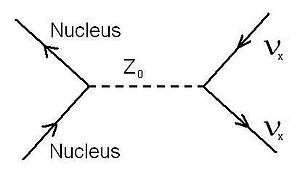 |
Introduction
Coherent Neutrino Nucleus Scattering (CNNS) is a neutral current process at low neutrino energies of about 1- 50 MeV. At low momentum transfers, a neutrino of any flavour scatters off a nucleus. Due to the small momentum transfer the neutrino interacts simultaneously with all the nucleons in the nucleus. So all the amplitudes of the wavefunctions are in phase and add up coherently. Thus the cross section for CNNS is very large compared to other neutrino cross sections. However the momentum transfer is still tiny, which makes CNNS hard to detect. In fact up to now CNNS has yet never been observed.
 |
The cross section for CNNS depends on the number of nucleons. Nuclei with larger mass numbers have a larger cross section for CNNS (in fact, the cross section depends on the square of the mass number). On the other hand the recoil energy is smaller for larger mass numbers. So the best detector material depends on the energy threshold (minimal detectable energy deposition) of the detector. For materials like tungsten or lead such a detector should have an energy threshold of less than 100 eV.
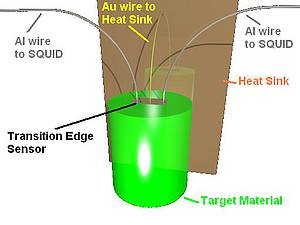 |
Cryogenic detectors in common
Our aim is to develop a cryogenic detector with a very low energy threshold, good energy resolution and a massive target.
The basic idea of such a cryogenic detector is that at low temperatures of about 10 - 20 mK the heat capacity of solids is very low (∼ T3). Thus a small amount of deposited energy (→ recoil energy of the target nucleus) leads to a measureable change in temperature. This change in temperature is measured with a transition edge sensor.
The transition edge sensor consists of a superconducting film evaporated either to a substrate, which is glued on the target crystal, or directly on the target crystal. The temperature of the entire detector, consisting of a target crystal and the transition edge sensor as a thermometer, is stabilized at the transition temperature of the superconducting film. Because of that a small change in temperature leads to an big change in resistance (in the figure below such a phase transition is shown).
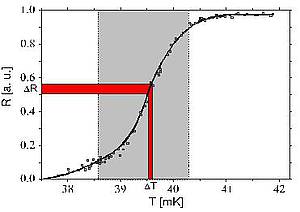 |
Cryogenic detector: working principle
A neutrino scatters off a nucleus. Thus momentum is transferred to the nucleus. The recoil energy is converted into phonons (→ lattice oscilations), which are running through the target crystal. The phonons are reflected at the surface of the crystal and can only leave the detector through the transition edge sensor, which is the only part which is thermally connected to a heat sink. So the phonons thermalize in the transition edge sensor and heat the superconducting film up in that way. Because of the increased temperature the resistance of the superconducting film increases. The resistace of the superconducting film (→ RT in the figure below) is measured with a SQUID (Superconducting QUantum Interference Device), which is a very sensitive sensor for magnetic fields. As the electric curcuit diagram below shows, the SQUID measures the magnetic field produced by a coil, which has the same current as the superconducting film.
 |
Background sources and background supression
There are several background sources:
electron recoils due to β and γ interactions. To discriminate between electron and nuclear recoils, a second signal (for instance scintillation light or ionisation charge) is needed. Due to the ratio between the second signal and the phonon signal the detector would be able to discriminate between electron and nuclear recoils
radioactive contaminations on the surface of the detector. As this type of events appere especially on the surface, the detector should be able to discriminate between surface events and events occuring in the interior. Such a discrimination can be done by a pulse shape analysis.
cosmic rays can be supressed by shieldings and a veto system especially for muons. Such a veto system consists of several scintillator panels, which surround the whole detector. Every time when there is an event in one of the scintillator panels, the signal of the detector is probably induced by cosmic rays (especially muons). Because of that, such events are deleteted.
epithermic and fast neutrons with energies up to a few 10 keV. Such neutrons can also be supressed with shieldings (especially polyethylene shieldings). Another possiblility for the supression of this neutrons would be the fact that neutrons interact mostly with light nuclei and the neutrinos interact mostly with heavy nuclei. The ratio of a second signal to the phonon signal is different for different target nuclei. So due to that ratio neutron events can be supressed.
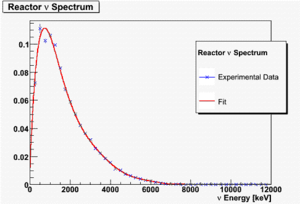 |
Outlook
If we succeed in developing a cryogenic detector with the specifications mentioned above (low energy threshold, good energy resolution and a massive target of several 100 g), the detector should be placed to an area with a very high neutrino flux of at least about 1013 neutrinos/cm2 s. Such a place could be the vincinity of a nuclear power plant with an thermal power of 2 GW.
On the figure on the left the neutrino flux of such a reactor is shown. The blue x's mark the experimental data and the red line marks a fit. This fit is used to calculate the expected counting rates for different materials.
On the figure below the result of this calculation is shown.
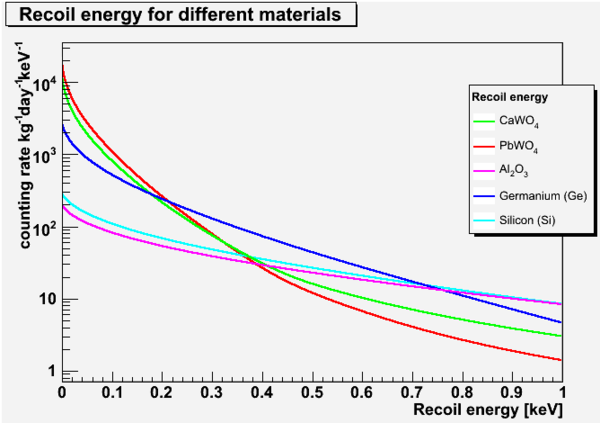 |
The most interesting thing shown by this figure is that depending on the energy threshold different materials would be the best for the target crystal. In an recoil energy range from about 150 - 750 eV Germanium has the highest counting rate. So Germanium would be the first choice, if the energy threshold of the prototype detector is in this energy range.
Germanium has also other advantages. Since it is used frequently in the semi conducter industry, Germanium could be purchased very pure. Germanium is also a semi conductor, so an ionisation signal occurs and can be used as a second signal for background supression.
Publications
Diplomathesis
Achim Gütlein - Entwicklung von Kryodetektoren zum Nachweis kohärenterNeutrinostreuung an Atomkernen
Posters
Poster for the SFB/Tr27: Development of cryogenic detectors for low energetic neutrinos
Poster for the SFB/Tr27: Solar neutrinos as background for the direct dark matter search
References
[1] K. Scholberg, Phys. Rev. D 73, 033005 (2006)
[2] B. Cabrera, L. M. Krauss, F. Wilczek, Phys. Lett. 55, 25 (1985)
[3] A. Bueno, M. C. Carmona, J. Lozano, S. Navas, Phys. Rev. D 74, 033010 (2006)
[5] A. Drukier, L. Stodolsky, Phys. Rev. D, vol. 30, pp.2295-2309 (1984)
[6] L.M. Krauss, Phys. Lett. B 269, pp. 407-411 (1991)
[9] C. J. Horowitz, K. J. Coakley, D. N. McKinsey, Phys. Rev. D 68, 023005 (2003)

